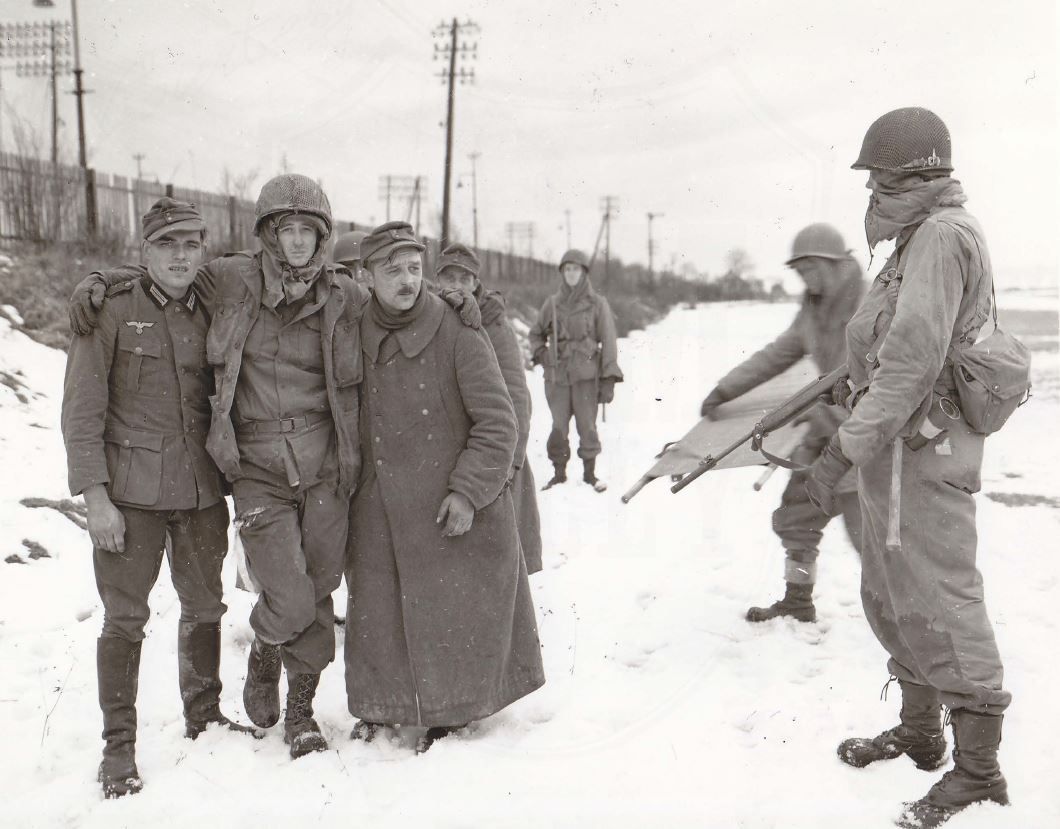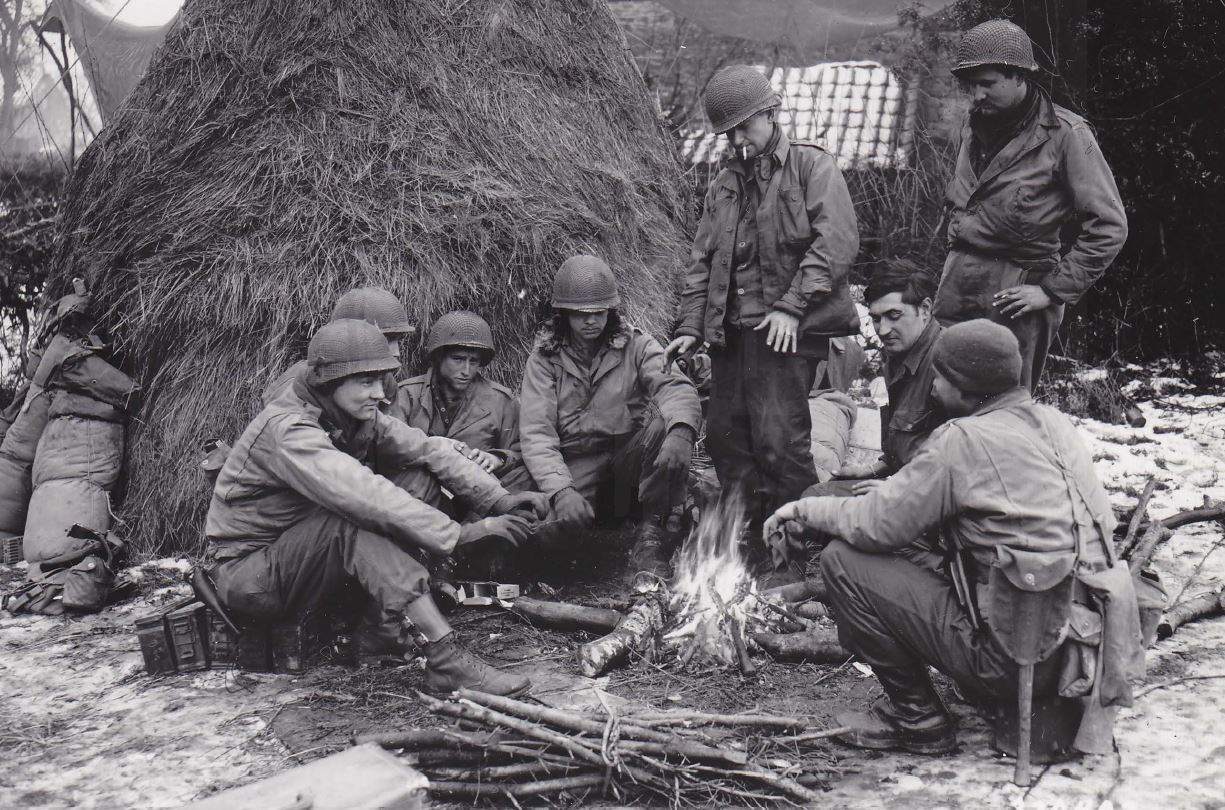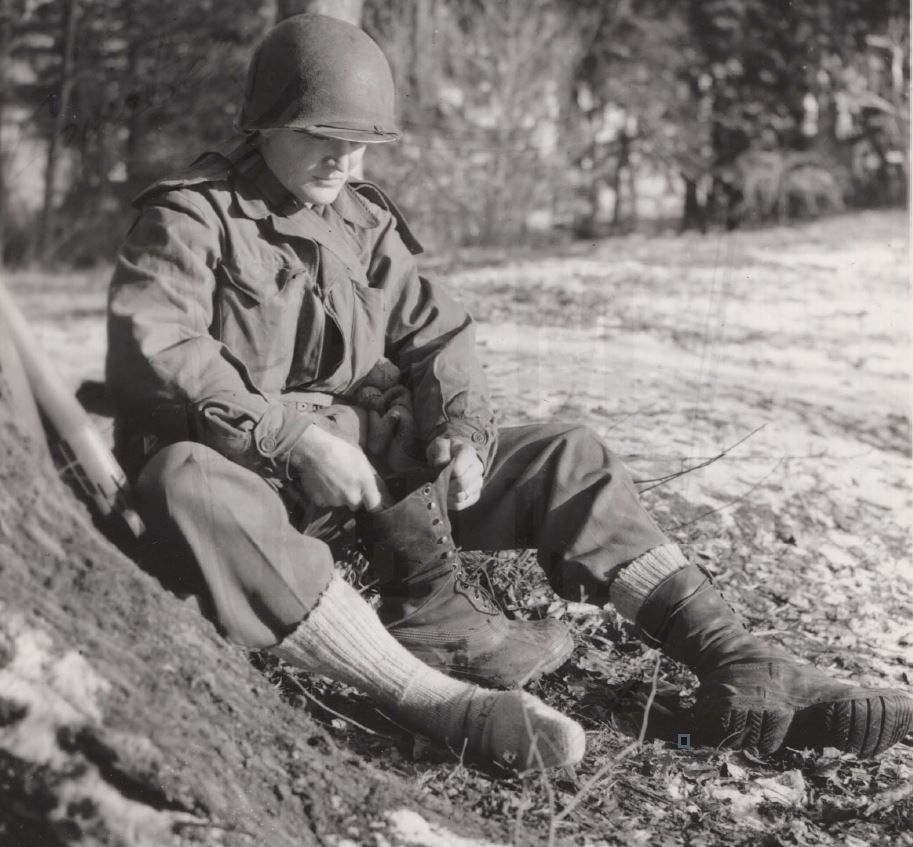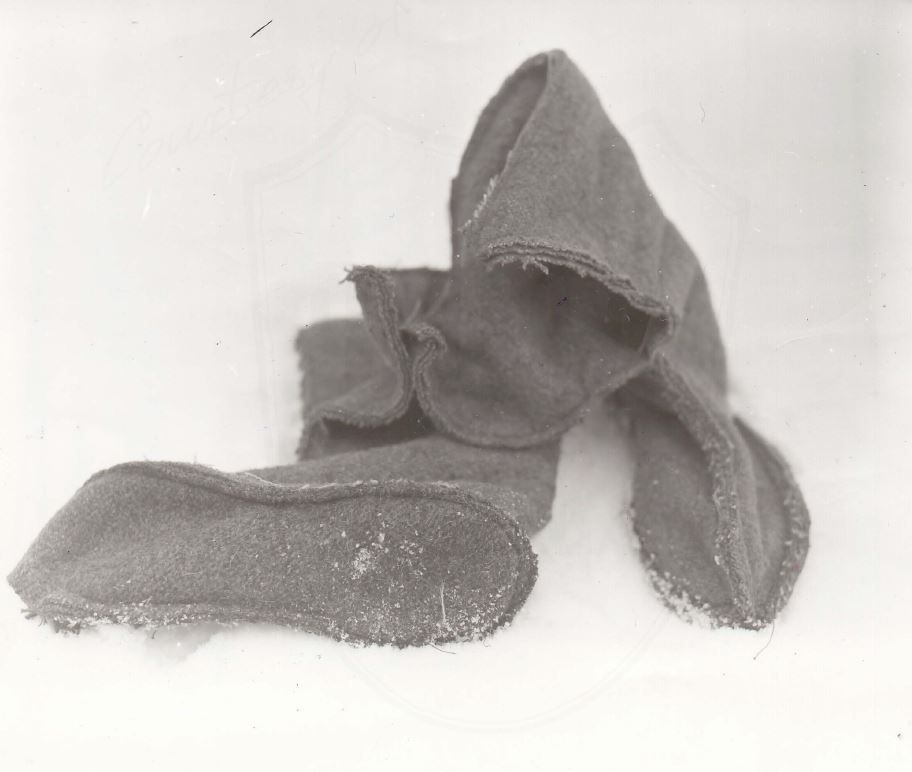* This article appeared in the Winter 2019 issue of the Army Medical Depart Historian Newsletter.
In late December 1944, Lieutenant A. Preston Price of the 1st Infantry Division was visited at his foxhole in Belgium by an old Citadel classmate serving in an adjacent company, Lieutenant Jack Lewis. Price’s unit was suffering many casualties from trench foot. Lewis complained, as usual, that he could not feel his toes. Price watched as Lewis, unaware that he had a severe case of trench foot, pulled of his combat boot and removed his sock and “several of his toes come with the cloth, leaving several naked toe bones exposed.”[1]
Cold Injury, Ground Type
“Cold Injury, Ground Type” or “trench foot”, plagued Army Ground Forces during the Second World War especially during the winter of 1944-1945 in the European Theater of Operations (“ETO”). Trench foot is a contracting of the blood vessels and reduction of oxygen supply to the tissues in the feet caused by the feet being wet for a prolonged period.[2] The symptoms of trench foot are numbness followed by swelling; then by intense pain; and, in some cases, by tissue death, with gangrene.[3] During the Second World War, the treatment was long, recovery slow, and sufferers were prone to recurrence.[4]

As early as November, 1944, falling temperatures and autumn rains contributed to rising trench foot rates that reached crisis levels even before the Battle of the Bulge.[5] The German counteroffensive in the Ardennes, and the brutal winter conditions during the winter of 1944-1945 further exacerbated the trench foot problem in the American armies. By late December 1944, stateside newspapers were reporting that trench foot was “as effective as bullets in knocking men out of battle” and that almost 18,000 men had been affected by the condition.[6] In total, during the months of November and December 1944 there were approximately, 23,000 losses to trench foot in the American armies, almost all combat infantrymen.[7] By late January more stories appeared in the American press describing the lack of proper clothing and equipment for American soldiers on the frontlines, including one from a reporter in the field with the 75th Infantry Division who wrote that, “The American doughboy, asked to fight the war under terrible winter conditions, is not equipped to meet it.”[8] The January 29, 1945 issue of Newsweek included a story titled “Shades of Valley Forge” detailing the failings of the Army Quartermaster Corps, specifically, “[t]he regulation shoes do not keep out the cold and dampness . . . The resulting trench foot may lead to gangrene and amputation.”[9] Meanwhile General Eisenhower’s headquarters rebuffed such reports as “isolated cases.”[10]
“The Men Devised Many Ingenious Ways to Cope”
On January 30, 1945, an older but otherwise non-descript infantry replacement arrived at the headquarters of L Company, 310th Infantry Regiment, 78th Infantry Division near Kozen, Germany. While several senior officers knew that the soldier, ostensibly a private, was in fact Major Arthur Goodfriend an editor of the Army newspaper The Stars and Stripes, Goodfriend’s identity was intentionally concealed so that he could learn first-hand how the front-line soldier withstood winter warfare conditions.[11]

The men of the company he joined did not embody the Army’s propaganda that the American soldier was “the best equipped soldier in the world” as they huddled around a woodstove in a forward command post wearing only field jackets (their heavy and clumsy overcoats long since discarded), many with gloves “out at the fingers” some wearing socks over or inside of them in order to prevent frostbite. Goodfriend noted that as a matter of necessity “the men devised many ingenious ways to cope with this problem and as a newcomer I received much expert advice.”[12] The veteran soldiers Goodfriend joined were quick to advise him to keep his feet dry and warm, but after his first day on the line he found that it was impossible to keep either his socks or combat boots dry and that the general consensus seemed to be that the Army’s combat boots were “rotten”.[13] Even the battalion commander told Goodfriend that he believed “The men who made the combat boot should be put in jail” because the boots soaked up moisture so easily.
The veterans told Goodfriend to put on two or three pairs of socks so long as they did not make his boots fit too tightly and decrease circulation, but with the caveat that “most of our shoes are too tight anyway and when they fill up with water they get even smaller.”[14] They also recommended that he stick a felt or cardboard pad into his overshoes, which Goodfriend had not discarded unlike most combat troops, and Goodfriend noticed that the men “grabbed the high thick felt and leather boots worn by some of the Germans” littered around the area.[15] According to Goodfriend, to the G.I. “rightly or wrongly the equipment he saw on Germans was generally rated as better than his own” and the “premature announcement of large quantities or winter equipment in the rear, on the ocean, or in preparation back in the United States had depressed the front-line soldier’s morale and weakened his respect for the Army”.[16]
“Lousy” Footwear
Due to failures in planning by the Office of the Quartermaster General, field commanders on the Continent, the Chief Quartermaster of the ETO, American combat troops were not properly supplied with uniforms and footwear for winter campaigning when they needed them most despite frantic efforts to rush those articles to the front.[17] In the final analysis, bluntly stated in the official history of the Quartermaster, “[t]o a large extent, the special cold climate clothing and equipment arrived in the ETO too late to be really useful during the coldest winter months”.[18]
The combat divisions of the American armies fighting in ETO during the winter of 1944-45 were issued a variety of footwear, all flawed and none a panacea for trench foot. Type II and Type III service shoes, ankle height boots were meant to be worn with canvas leggings, which when wet from snow would freeze, tighten, and restrict blood flow to the feet.[19] The critical difference between these boots was that the Type II had a smooth-surfaced leather whereas the Type III shoe had a flesh-side-out or “reversed upper” leather. Some soldiers, like those in the 78th Division observed by Major Goodfriend, were equipped with the new “combat boot” which was approximately 10 inches high and had a flesh-side-out bottom, like the Type III service shoe, but had a smooth-surfaced leather cuff with two buckles that dispensed with the need for leggings.[20] To waterproof the soldiers’ boots the Army supplied dubbin or dubbing, a wax and oil mixture. However, in one battalion commander’s estimation (later confirmed by the General Board of the ETO), “all the dubbin in the world” could not keep moisture out of the combat boots his troops were issued and, worse still, it shut out air making the soldiers’ feet perspire more and their feet colder.[21]
All of the aforementioned types of boots were meant to be worn with canvas or rubber overshoes in winter conditions, however, overshoes were of marginal utility in combat operations. They were cumbersome and, more importantly, were an extra pair of boots that a soldier needed to carry. Therefore, overshoes were routinely lost or abandoned.[22] A soldier in the 90th Infantry Division noted that overshoes were discarded because they “filled with water and made running or walking an exhaustive labor.” [23] An 84th Infantry Division soldier, “gave up on the overshoes. You couldn’t run in those things—they were too heavy” and a soldier in the 26th Infantry Division left his overshoes along the side of a road because “they had not kept my feet dry and had rubbed my heels raw with blisters.”[24] Some soldiers stuffed straw or newspapers inside their overshoes which served two purposes, it insulated the feet and improved the fit of the boots in the overshoes.[25] Others, rather than discard their overshoes, threw out their boots. Eugene "Art" Broadhurst, a combat engineer in the 75th Infantry Division, had been issued combat boots that "took up water like a sponge" and rubber overshoes that "let snow in at the top." When he found a sheepskin hanging in a barn he fashioned a pair of moccassins that he could wear inside of his overshoes and threw away his combat boots. [26] James H. Langford, a rifleman in the 99th Infantry Division, recalled that during the first days of the Battle of the Bulge “The overshoes were too small to fit over my shoes and I could not keep [my] feet in condition with just the shoes” and so Langford improvised, “I had on a pair of four-buckle overshoes and three or four pairs of socks in order to keep my feet warm and dry.”[27] Another 99th Division soldier, William F. McCurdie recalled that a sergeant in his platoon likewise did not wear boots, but rather seven pairs of socks inside of his overshoes.[28]

The shoepac, a high moccasin type boot with rubber foot and leather top and issued with felt insoles, was considered the best form of foot gear for preventing trench foot in the ETO.[29] However, during the harshest winter months of 1944-1945 the shoepac was only issued in large numbers to infantry troops of the 7th Army in the Vosges Mountains of France.[30] The 7th Army, unlike the other American armies in Northwest Europe, had drawn its winter supplies through Mediterranean Theater supply channels.[31] Having learned hard lessons during the winter of 1943-1944, in which one in four American casualties during the period of December 4, 1943 – February 19, 1944 were a result of trench foot, quartermasters in the Mediterranean proactively requisitioned large numbers of shoepacs.[32] The shoepac was still imperfect, the leather tops were not waterproof, their rubber soles wore out quickly, and the rubber bottoms failed to ventilate the foot which caused excess sweating and a condition known as “shoepac foot.”[33] Robert J. McDonnell, a rifleman in the 79th Infantry Division recalled that when wearing shoepacs his feet “sweat so much that after a good hike you could remove your socks and wring the sweat out.”[34] Also, the felt innersoles dampened easily and were hard to dry. To combat this, soldiers in the 100th Infantry Division made replacements from discarded cardboard 10-in-1 ration boxes.[35]
The problems with the footwear issued to American soldiers in ETO during the winter of 1944-1945 were legion, but perhaps the most eloquent summation of the Chief Surgeon of the ETO, Major General Paul R. Hawley, who reported in late 1944, “The plain truth is that the footwear furnished U.S. troops is, in general, lousy.”[36]
The 30th Infantry Division’s Blanket “Booties”
The 30th Infantry Division may have created the most ingenious expedient item to combat trench foot. The 30th Infantry Division did not receive specialized winter equipment like mittens, heavy jackets, snow capes, and shoepacs in large quantities until after its part in the Battle of the Bulge was over.[37] The division’s history notes that in the bitter cold the infantrymen were “hardest hit by weather as well as bullets” and that “[t]he main reason why many line-company soldiers kept fighting was to get themselves houses within which to bed down.”[38] Colonel Branner P. Purdue, the commander of the 120th Infantry Regiment which along with the rest of the division was heavily engaged in reducing the Bulge salient, arranged to have “booties” made from salvaged and captured blankets to provide warm footwear for his troops. Each pair of booties was cut in the approximate shape and size of the combat boot and sewn three layers thick, but were compact enough to be carried inside a soldier’s shirt until they were needed.[39] By the middle of January 1945 enough booties had been made to provide them to every soldier in the regiment, and to each new replacement upon their arrival.[40]

Captain Murray Pulver, a company commander in the 120th Infantry, recalled that “the booties inside of our overshoes made very warm footwear.”[41] To Gus Rouff, a mortarman in the 120th Infantry, there was “no doubt they saved many of us from getting trench feet.”[42] Rouff carried his booties inside of his shirt until periods of inactivity when he could remove his wet combat boots to dry, and wear his booties inside of his overshoes.[43] Captain Pulver wore his booties inside of his overshoes during an attack, a decision that saved him from serious injury when a German grenade landed under his right foot and exploded. Pulver’s overshoe was blown to pieces, but the extra thickness of the bootie had absorbed much of the force of the explosion and left Pulver with only a bruise on his foot.[44]
The 30th Infantry Division’s booties received substantial attention in The Stars and Stripes and Newsweek.[45] Other units, like the 8th, 78th, and 44th Infantry Divisions appear to have produced their own booties based off of Col. Purdue’s example, and Medical Department’s history of the European Theater acknowledged that the wearing of blanket booties inside of overshoes was one of the best forms of protection developed against trench foot in part because the toes and feet were allowed free movement typically lacking in other footwear.[46]
Too Little, Too Late
While it is difficult to evenly apportion blame unpreparedness of the American armies in the ETO during the winter of 1944-1945, it is much easier to quantify the effect of the resultant trench foot epidemic.[47] From October 1944 to April 1945, 46,107 (the approximate strength of three infantry divisions) American soldiers in Europe were hospitalized for trench foot, amounting to 9.25% of the total number of casualties during the entire Continental campaign.[48]
Ironically, by the time supplies of winter footwear arrived in sufficient quantities to equip all combat troops and the Army’s trench foot prevention education campaign began in earnest the fighting waned, temperatures rose, and the trench foot rate plummeted.[49] While merely a footnote in the Battle of the Bulge epoch, the ad hoc methods of preventing trench foot demonstrate how despite material shortages of critical winter uniform items, unit commanders and individual soldiers maintained combat effectiveness in one of the worst winters in recent history.
Footnotes
[1] Arthur Preston Price, The Last Kilometer: Marching to Victory in Europe with the Big Red One: 1944-1945, (Annapolis, MD: Naval Institute Press, 2002), 34.
[2] Graham A. Cosmas and Albert E. Cowdrey. Medical Service in the European Theater of Operations, (Washington, D.C.: Center of Military History, 1992), 489.
[3] Ibid.
[4] One afflicted infantryman’s feet were so swollen that he could not wear shoes for six months. Carlton Stouffer, Pfc. Carlton Stouffer, 13128357: Rifleman, (N.p., 1996), 248A; Cosmas and Cowdrey, Medical Service, 489.
[5] Cosmas and Cowdrey, Medical Service, 492.
[6] “Trench Foot Quelled in European Theatre,” Daily Boston Globe, December 27, 1944, 6.
[7] Cosmas and Cowdrey, Medical Service, 494.
[8] Bell, Jack, “Thousands of Doughboys Hobbling on Frozen Feet,” Los Angeles Times, January 27, 1945, 1.
[9] “Shades of Valley Forge,” Newsweek, January 25, 1945, 33.
[10] “Ill-Clothed Yanks at Front Declared 'Isolated' Cases,” Daily Boston Globe, January 26, 1945, 4.
[11] Arthur Goodfriend, “Battle in the Snow,” Infantry Journal, May, 1946, 28.
[12] Ibid., 31.
[13] Ibid.
[14] Ibid., 34.
[15] Ibid., 33.
[16] Ibid.
[17] Tom F. Whayne and Michael E. Debakey, Cold Injury, Ground Type, (US Army Medical Department, Office of the Surgeon General, Department of the Army, Washington, DC, 1958), 150.
[18] William F. Ross and Charles F. Romanus, The Quartermaster Corps: Operations in the War Against Germany, (Washington, D.C. : Center of Military History, 1991), 597; Ibid., 154.
[19] Ed Cunningham, “U.S. Soldiers on the Western Front Learn to Fight Weather the Hard Way,” YANK, March 2, 1945, 3.
[20] Eudora Ramsay Richardson and Sherman Allan. Quartermaster Supply in the European Theater of Operations in World War II. Vol. III. (Camp Lee, VA: Quartermaster School, 1948), 84-85.
[21] “Trench Foot Quelled,” 6; Goodfriend, “Battle in the Snow,” 34; Richardson and Allan, Quartermaster Supply, 85; Report, General Board, United States Forces, European Theater, Medical Section Study No. 94, Subject: Trench Foot, 4. https://usacac.army.mil/sites/default/files/documents/carl/eto/eto-094.pdf (accessed September 30, 2019). While dubbing was “supplied in lavish quantities. It did not make boots and shoes waterproof, and the men complained that it made their feet perspire because it shut out air and therefore kept their feet cold.” Whayne and Debakey, Cold Injury, 152. Of interest is that the 5th Infantry Division was seemingly the only unit in the ETO to believe that dubbing was effective. However, it is unclear if, or to what extent, their opinion of dubbing was influenced by other preventative measures such as frequent changes of socks and the massaging of the feet. Headquarters Communications Zone, European Theater of Operations, Office of the Quartermaster, Quartermaster Field Observation Report No.7, December 1944. http://cgsc.contentdm.oclc.org/cdm/ref/collection/p4013coll8/id/919 (accessed October 2, 2019).
[22] General Board, Trench Foot, 4; Harold P. Leinbaugh and John D. Campbell. The Men of Company K: the Autobiography of a World War II Rifle Company (New York, NY: William Morrow and Company, Inc., 1985), 45.
[23] Dale Lindhugh, Show Me the Hero: an Iowa Draftee Joins the 90th Infantry Division during WW II in Europe (Bloomington, IN: AuthorHouse, 2009), 42.
[24] Bruce E. Egger and Lee MacMillan Otts, G Company's War: Two Personal Accounts of the Campaigns in Europe, 1944-1945. Edited by Paul Roley (Tuscaloosa, AL: University of Alabama Press, 1998), 34.
[25] Cunningham, “Hard Way,” 3; Seaman, Michael, “These are the Frosty Lessons of Winter Warfare,” The Stars and Stripes, February 3, 1945, London edition, Warweek, iii.
[26] Paul E. Cunningham, Freezing in Hell : World War II, Ardennes, Battle of the Bulge, December 16, 1944-January 25, 1945, (Salisbury, MD: P.E. Cunningham, 1998), 91.
[27] Jim Langford, "Experiences of an Infantry Squad." CHECKERBOARD 99th Infantry Division Association. Accessed March 03, 2019. http://99div.com/.
[28] William F. McMurdie, Hey, Mac: A Combat Infantryman's Story, (Cameron, MO: American Home School Pub., 2000), 104. While perhaps counter-intuitive, discarding tight-fitting combat boots which restricted free movement of the toes and wearing six or eight pairs of wool socks within the overshoes was considered one of the best protections against trench foot. Cosmas and Cowdrey, Medical Service, 493; Coates and Bays, Cold Injury, 159.
[29] Ross and Romanus, Operations in the War Against Germany, 195; General Board, Trench Foot, 4.
[30] Coates and Bays, Cold Injury, 150.
[31] John Boyd Coates and S. B. Bays. Cold Injury, Ground Type, (Washington, D.C.: Off. of the Surgeon General, Dep. of the Army, 1958), 154.
[32] Coates and Bays, Cold Injury, 105.
[33] Cosmas and Cowdrey, Medical Service, 492.
[34] Robert J. McDonnell, Dogface: My Experiences as a Combat Infantryman in WWII (New York, NY: M2 Press, 2011), 173.
[35] Charles B. Kelleher, "Inner-Soles Cut From Cardboard Boxes Aids War on Trench Foot,” Century Sentinel." Vol. II, No. 72, February 17, 1945, 2.
[36] Cosmas and Cowdrey, Medical Service, 492.
[37] Hewitt, Robert L. Hewitt, Work Horse of the Western Front: the Story of the 30th Infantry Division, (Washington, D.C.: Infantry Journal Press, 1946), 195.
[38] Ibid., 207.
[39] Jones, Russ, “Sleighs Carry Front Supplies,” The Stars and Stripes, January 15, 1945, London, 2; Gus Rouff, From Holland to the Rhine : A World War Two Account, (N.p.,: CreateSpace Independent Publishing Platform, 2013), 31.
[40] Caption to ETO HQ 45 9310 Photograph, “20 January. Credit...US Army Signal Corps Photog...Pfc. Murray Shub-165. Taking the well-known 'ten minute break' are, L-R: Sgt. Albert L. Soli, Westwood, Calif., Pvt. Jimmy Ferguson, Granby, MO., and T/Sgt. Robert Kircher Maplewood, N.J. Pvt. Ferguson is displaying his ‘booties’ which are used to replace shoes and socks when they get wet. These ‘booties’ or shoe-pacs as they are sometimes called, are a new winter innovation, and when not worn, are carried by the men inside their shirts for warmth. (F) 30th Div, Gerimont, Belgium.” https://www.ww2online.org/image/soldiers-keep-warm-around-small-fire-g%C3%A9rimont-belgium-20-january-1945 (accessed October 1, 2019).
[41] Murray S. Pulver, The Longest Year, (Freeman, S.D.: Pine Hill Press, 1986), 75.
[42] Rouff, From Holland to the Rhine, 31.
[43] Ibid.
[44] Pulver, The Longest Year, 95.
[45] Jones, “Sleighs Carry Front Supplies,” 2; “Shades of Valley Forge,” 33.
[46] Goodfriend, “Battle in the Snow,”32; Seaman, “Frost Lessons,” iii; The 44th Infantry Division reference is a U.S. Army Signal Corps photograph taken around January 25, 1945, showing a soldier near Sarreguemines, France wearing “Fox-Hole Boots” made from blankets and filled from straw, Record Group 111, National Archives, 111-SC-199545. The 101st Airborne Division supplied its soldiers with foraged burlap bags during the defense of Bastogne, and other units wore white plastic powder bags for artillery ammunition inside or outside of their shoes. Laurence Critchell, Four Stars of Hell (New York: Berkley Books, 1987), 241; Coates and Bays, Cold Injury, 159; Cosmas and Cowdrey, Medical Service, 493.
[47] Cosmas and Cowdrey, Medical Service, 496.
[48] General Board, Trench Foot, 1.
[49] Cosmas and Cowdrey, Medical Service, 495-96; Ross and Romanus, Operations in the War Against Germany, 606-608. According to 84th Infantry Division Mike Chirco, his unit received shoe pacs after being withdrawn from the Battle of the Bulge fighting in late January, replacing their combat boots that in Chirco's words, "acted like a sponge, soaking up all available water." The next day his unit was ordered to turn in their new shoe pacs for combat boots because "now that Winter was over, they would slow us down." Mike Chirco, Echoes from a Foxhole, (Rochester, NY : Olde Ridge Publications, 1995)117-18.